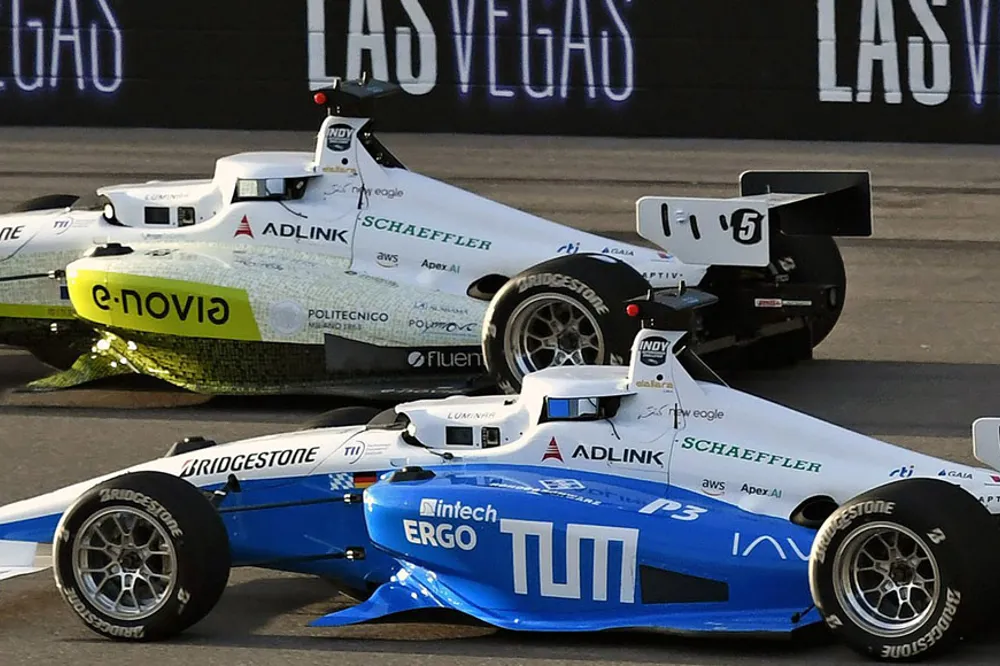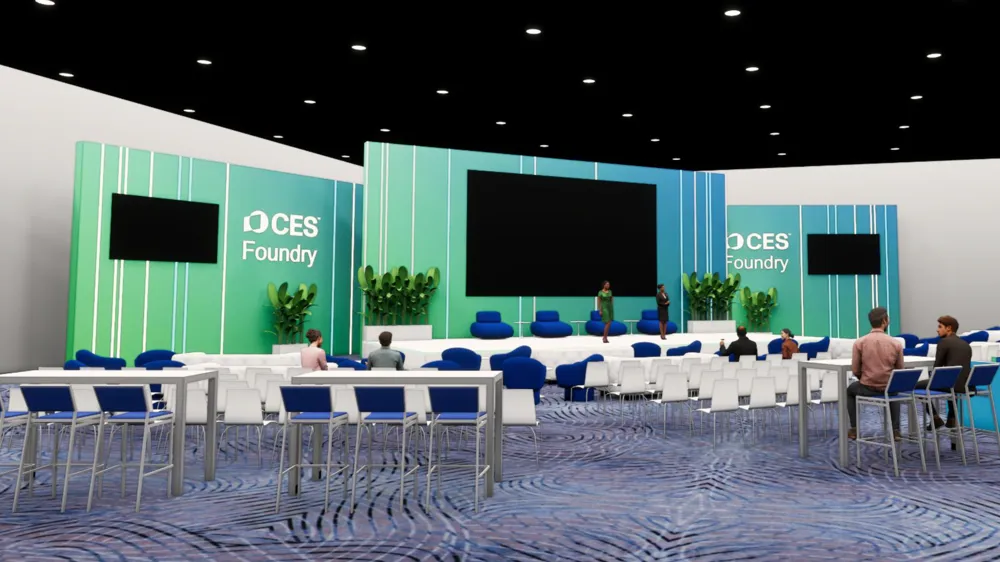To The Races
January 18, 2023

- Author: Robert E. Calem
These formula cars help researchers solve autonomous driving challenges, on and off the track.
For the second consecutive year in 2023, in-person and online CES® attendees can catch the Indy Autonomous Challenge, a competition among self-driving, open-wheel race cars, at the Las Vegas Motor Speedway on Saturday, Jan. 7. To understand how the race contributes to the evolution of car tech for ordinary vehicles, i3 spoke with Paul Mitchell, president of the Indy Autonomous Challenge. Not coincidentally, if ironically, his office is located within walking distance to the legendary Indianapolis Motor Speedway, in Indianapolis, IN, where human drivers still dominate. (His remarks have been edited for clarity.)
Why was the Indy Autonomous Challenge created?
There are three reasons IAC exists. First, to try to accelerate the pace of technology innovation for high-speed automation. Second, to attract and grow the best and brightest minds in the workforce that’s needed for the autonomous industry to grow. And third, to win hearts and minds by showcasing autonomous technology in a way that the average consumer can see and be amazed. If you think about most autonomous vehicles to date, the focus has been on low-speed automation — urban and suburban robotaxis — and when people see those vehicles moving at lower speeds, they say, “Well OK, I can drive myself that way.” We know there’s a lot of technology that goes behind that, but when they see a Formula race car zipping around a track at 170 miles per hour (MPH), they can look at that and say, “Wow, that’s not something I could do.” The fact that a robot can do that is kind of whimsical, and maybe they should be more comfortable riding in an autonomous vehicle in the future, going 20 or 30 MPH down their street.
Indy is in the name. Is IAC linked to INDYCAR and its series of open-wheel car races?
Indiana is the hub of open-wheel motorsports. A lot of the racing teams are here, most of the INDYCAR and even some of the teams that have connections into Formula 1. And Indiana is a big automotive manufacturing state. The Indy Autonomous Challenge came together with investments from the state of Indiana and interest from Indianapolis Motor Speedway to create a global initiative.
We started at the end of 2017 thinking about how we could connect Indiana’s heritage in motorsport and the famed Indianapolis Motor Speedway with the emergence of advanced technology vehicles, particularly autonomous vehicles. We were thinking about how those two worlds could come together and concluded that a prize competition that would build on the experience and the legacy of the DARPA Grand Challenge held in 2004 and 2005, which helped jumpstart the autonomous vehicle industry — something like a new DARPA Grand Challenge but with race cars on a world class racetrack — would get a lot of attention from industry and top universities around the world. And that’s exactly what happened.
Our first race was held at the Indianapolis Motor Speedway, Oct. 23, 2021. Our second race was at Las Vegas Motor Speedway, Jan. 7, 2022, during CES.
Were there any differences between those two races?
The evolution has been significant. In our first race, at the Indianapolis Motor Speedway, it was just one car at a time. There were time trials to see which car could go the fastest around the track. And while we had some obstacle detection and avoidance, it was done with pylons, almost like a slalom course. A few months later we demonstrated head-to-head racing, where cars passed each other at speeds as high as 170 MPH on the track at Las Vegas Motor Speedway. A big leap was made between those two events.
Another event, held on November 11 at Texas Motor Speedway, and the race at Las Vegas Motor Speedway during CES 2023, build on our passing competition format, which involves head-to-head racing of two teams passing each other at higher and higher speeds until essentially one team gives up or crashes.
We’re going to continue to push the boundary of what these cars can do from a speed standpoint as well as more aggressive passing and defending behavior between the vehicles.
"The goal is that the technology on the cars evolves constantly, every year, to feature the absolute cutting edge, really the bleeding edge, of autonomous technology."
How has the cars’ technology evolved to meet the new challenges? Does IAC set specs?
The cars are all identical. The race car itself is built by Dallara, which is an Italian race car manufacturer, and it’s based on the Indy Lights chassis. Indy Lights is the theater series to INDYCAR. Indy Autonomous Challenge integrates those cars and converts them to be autonomous by installing hardware and software on the vehicles. Then our university teams develop the code and the software that essentially function as the robot driver.
The hardware, software and some technology services are all donated to us by partners that are industry leaders such as Luminar, Continental, Bridgestone, DSpace, AWS (Amazon Web Services) and Cisco. Part of our mission is to validate the technology for these industry partners.
Between the last race we ran at CES and this race, [with a bigger turbocharger] we boosted the top speed of the cars. We now set an autonomous land speed record of 192.2 MPH — that was set April 28, 2022, at the Kennedy Space Center. And we also added a new central computer from DSpace, [as well as] some additional GPS technology from a company called VectorNav, and made some other improvements and upgrades to the systems, which we believe will allow these cars to race better. By the way, we also hold the records for the fastest lap, the fastest overtake, and all racing records for autonomous vehicles. At CES 2023 we will announce additional changes that will be made to the cars and additional sponsors who will join and provide technology for the cars.
The goal is that the technology on the cars evolves constantly, every year, to feature the absolute cutting edge, really the bleeding edge, of autonomous technology.
Will the self-driving tech in these race cars ever cross over to ordinary vehicles?
They are different challenges. The way in which sensor fusion works in a low-speed scenario is, a lot of information must be taken in, because there’s a lot of uncertainty as to what happens. You’ve got to look for the lights, you’ve got to look for the turn signals, look for people, and detect and determine whether that’s a baby crossing the street or a ball bouncing, and so on. But you do that in an environment where you have some level of time to make decisions.
When you move to speeds in excess of 80, 100, 120 MPH, your ability to make decisions and the need for the sensor fusion, and the incredibly low latency that’s required to track a vehicle that’s coming at you or behind you, observe it and make a decision on which direction to move — without knowing what that other autonomous vehicle is going to do — is something that, quite honestly, has not been done by industry. The very first time it’s been proven out as even a concept is through the Indy Autonomous Challenge. We set the technical competition around those concepts the industry was not capable of doing yet, but which academia had been seeking to validate in the real world.
The focus we have on high-speed automation directly aligns with the need to improve highway safety while also opening the potential that vehicles, over time, will travel on highways at speeds that human drivers might not feel comfortable at, or even be competent to drive at based on their skills. We can begin to move freight, perhaps people but certainly freight initially, at speeds in excess of 100 MPH, maybe in excess of 120 MPH or 150 MPH, safely on highways in the future because of this type of technology. And doing that would allow goods and services, the supply chain and people’s travel time to improve dramatically in terms of speed and logistics.
For the auto industry, we offer two real value propositions. First is a proving ground for hardware and software to operate under these extreme challenging conditions or edge cases. Second is a pipeline for world class talent. The people who participate on our teams are largely PhD students at the most elite engineering universities in the world — MIT, Carnegie Mellon, Technical University of Munich, for example — and they’re largely AI roboticists, machine learning data scientists. They are not inherently automotive. In fact, if you ask some of our team members, several don’t own a car and have never driven. And now, maybe, they’re going to spend their careers working on autonomous mobility.
What role does IAC’s alliance with CTA and a race during CES play in all of this?
CES is the perfect partner and venue for Indy Autonomous Challenge. The audience fully understands and appreciates the technology and the challenges of what we’re doing. The interest that our teams have, and that our sponsors have, in showcasing this technology at a world class event like CES is terrific. Many of our sponsors are major exhibitors at CES already. There’s also an international component to CES, and the companies and the governments of countries [from which] we have teams coming are present at CES. Those are just a few reasons the partnership with CES has been incredible, in addition to the fact that you have so much tech media and industry media present and interested in what we’re doing.
Certainly, this week’s IAC race won’t be the last. How will IAC itself evolve?
After the race at Las Vegas Motor Speedway during CES 2023, we will transition to closed track road courses, through this year and into 2024. We may continue to run on ovals, but we will have demonstrated high-speed passing and maneuvering around ovals. We want to showcase what can be done at very high speeds on road courses that mimic the kinds of turns and lane changes, [for instance], that you would find on highways.
Join our community of innovators and shape the future of technology.



